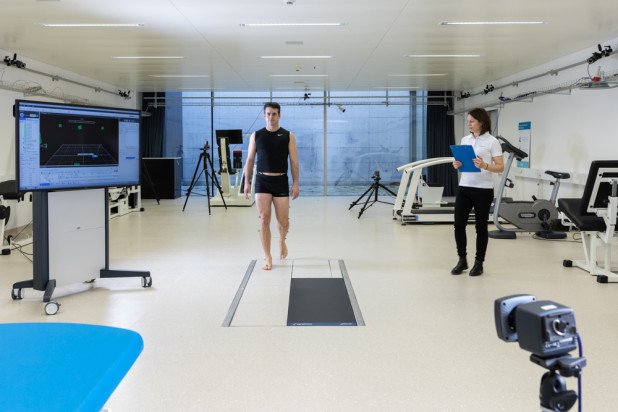Clinical movement analysis
In the clinical movement analysis group, we investigate the movements and active forces in persons with various orthopaedic pathologies, such as joint replacement, injuries or musculoskeletal restrictions.
Links between different parameters
Clinical movement analysis helps us to understand the link between patient characteristics (e.g. age, sex, weight), the treatment option selected (e.g. implant type, surgical technique, rehabilitation programme) and the surgical result (improvement in mobility and quality of movement). This analysis helps surgeons to make decisions regarding the optimum treatment for individual patients.
State-of-the-art technology
In order to carry out movement analyses, our Human Performance Lab uses a three-dimensional (3D) movement analysis system equipped with 13 cameras, four force plates embedded in the floor, a large foot pressure measurement plate and an electromyography (EMG) system.
In collaboration with the Institute for Biomechanics at ETH Zurich, Schulthess Klinik also operates a mobile fluoroscope at ETH Zurich. This instrument illustrates the movements of a joint implant during various physical activities and is used to assess the individual joints – particularly following joint replacement surgeries. The research focuses on how implant designs and operation techniques affect movements as well as the resulting implant loads.

In collaboration with the Institute for Biomechanics at ETH Zurich, we also operate a mobile fluoroscope at ETH Zurich. This instrument visualises the movements of a joint implant during various physical activities and is used to assess the functionality of individual joints – particularly following a joint replacement. The research focuses on how implant designs and operation techniques affect movements as well as the resulting implant loads.
Large-scale studies
In addition to small individual studies, the Research department also examines specific patient groups in the Human Performance Lab as part of large-scale studies. The aim of these prognostic studies is to determine the functional capability of patients during various everyday activities. They make it possible for us to identify certain patient characteristics that are associated with treatment outcomes.
Large-scale studies are intended to help surgeons select the optimum treatment and gauge expected treatment outcomes so that they can increase patient satisfaction.
Schulthess Klinik
Lengghalde 2
8008
Zürich
Schweiz